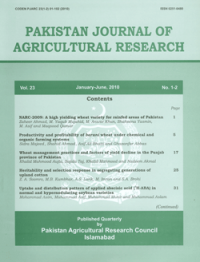Sumia Bint Zaman, Sidra Majeed and Shahid Ahmad*
ABSTRACT
Globally resources of petro-fuels are diminishing at a rapid rate. Efforts are underway to develop sources of bio-fuels. Out of the known sources of bio-fuels, Jatropha is one of the most promising option. The purpose of this study was to evaluate primarily the regional and global experiences to assess the potential of Jatropha farming in Pakistan and to conduct a comparative economic analysis of alternate feasible options e.g. production of oilseeds, which are also being imported in large quantities. Temporal analysis (1950-09) for edible oil consumption, production and imports is made. Projections for edible oil are worked out up to 2030. As there have been large variations in yield of Jatropha reported by various studies conducted in India and other countries, therefore most reliable data have been selected for analysis to assess the prospects in Pakistan. Comparative economic analysis is made in terms of oil contents, number of crops per year, yield and gross returns of oilseed crops and Jatropha. Analysis shows that increase in production of edible oil over the time is negligible against the large increase in requirement resulted in higher production gap being filled through imports. Projections made for edible oils illustrated that production gap is going to be wider, which is currently 1.86 million tonnes (mt) and projected to be 3.4 mt by 2030. Jatropha seed production analysis of water-yield functions revealed that yield varies from 1.1 t ha-1 in drought or dry spells to 12.75 t ha-1 with full irrigation in favorable environments. Benefit-cost analysis shows that break-even point can be achieved in fourth year of plantation of Jatropha. The projected consumption in Pakistan for petro-fuel for 2025 is 35.1 mt, which is almost double of the current consumption. Thus, the target projections for replacement of petro-fuel with bio-diesel will be 3.51 mt for which 3.5 mha of land is required, as Jatropha has to be grown in marginal areas with marginal yields. Comparative economic analysis shows that for sunflower and canola all conditions are favorable, as per frequency of crops, price and returns as oilseed get returns of 166% higher than Jatropha. Oil contents of sunflower and canola are higher than Jatropha. Analysis concludes that it is more feasible to grow oilseeds because in trade-off between food and fuel, food should win. Before launching commercial production of Jatropha in Pakistan key issues need to be addressed including maintaining the goal of food security, water scarcity, cost-effectivity, and feasibility of Jatropha in comparison with oilseeds, pulses, feed crops and fuel-wood plants.
To share on other social networks, click on any share button. What are these?






